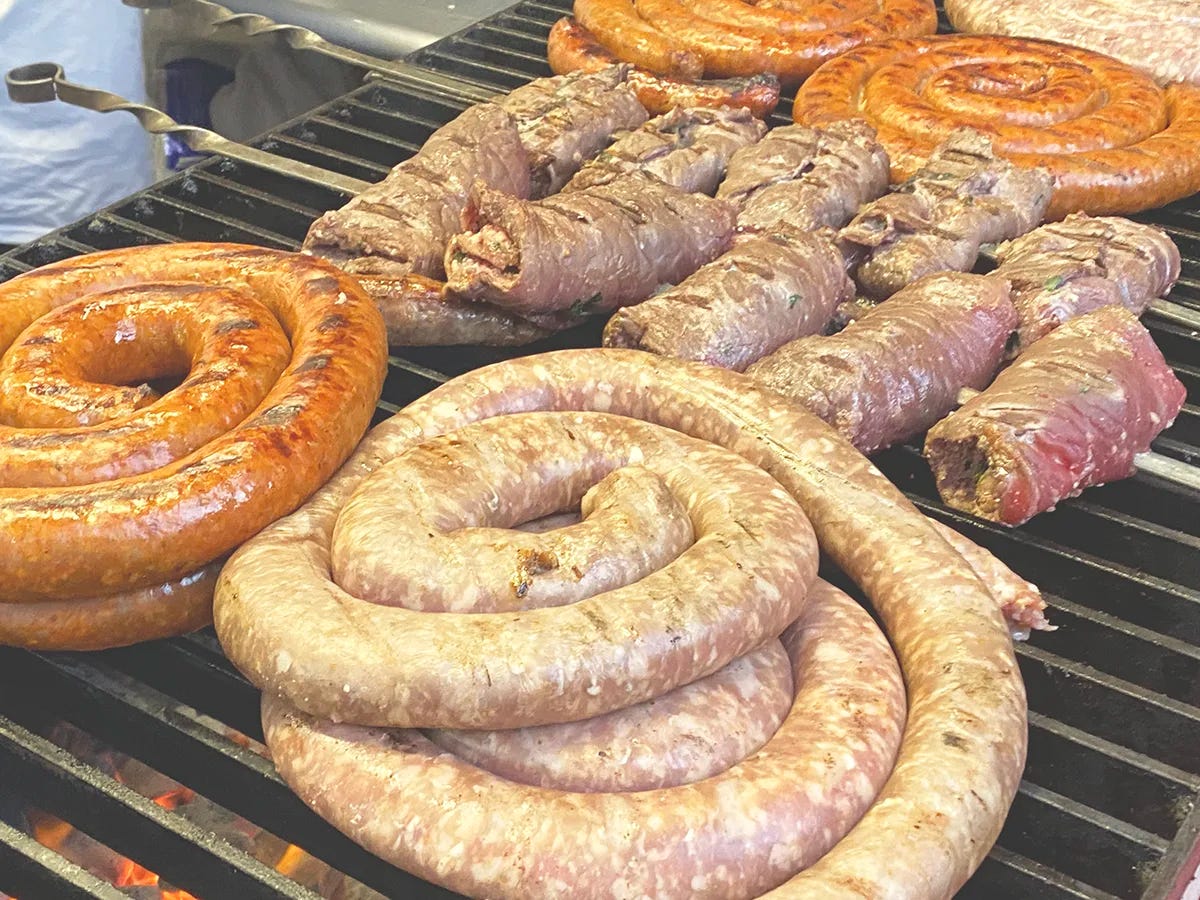Food Notes: 9/23
Sausage and peppers, sour beers, Italian wontons, Chinese ravioli, and more
This past week was the Feast of San Gennaro in New York City, a food-filled street party spanning Little Italy in Manhattan.
I happened to go the festival twice. I attended in the evening early in the week with my wife, in-laws and feisty four-year-old. We sampled some foods, filled the four-year-old with zeppole, and then I watched while my wife, mother-in-law, and four-year-old spin around in the tea cup ride.
Later in the week I returned in the afternoon meeting up with food writer Mark Rotella, author of Stolen Figs. In the early afternoon, it’s easier to gawk at the food on offer and the crowds are smaller. Before we left, Mark bought himself a braciole sandwich.
Most attendees are familiar with the sausage and pepper sandwich. Sausage and peppers are an icon of Italian American cuisine, especially in relationship to street fairs. They were sold at San Gennaro starting at the second or third festival in the late 1920s. The first to sell the sandwiches at the Feast was John Fasullo whose family still has a stand, but today there are at least five or six distinct vendors.
By the 1940s, just about every write-up about the San Gennaro festival mentioned the sausage and peppers. Calvin Trillian even has entire New Yorker article dedicated to his search for the perfect sandwich in 1981.
These are hefty sandwiches, and they ran about $18 to $20 at this year’s Feast. They can more than fill you up, and usually I hesitate to order one because its a lot of food—and don’t you want to sample all the other good things at the festival?
Most of the vendors today also serve a braciole sandwich. Braciole is an Italian American name for involtini, a thin slice of meat that is stuffed with a filling and rolled together like a savory Swiss roll. Stuffings vary, but often include garlic, herbs, and cheese.
I’ve made pork braciole stuffed with parmigiana, Prosciutto, and breadcrumbs. But the braciole I have made has always been served in sauce, a “Sunday gravy,” as is sometimes said in the tri-State area to designate meat ragù cooked on Sunday. When I make braciole at home, the meat braises in the sauce, adding flavor.
At the festival, the bracioles are grilled alongside the sausages, peppers, and onions, and then served on a hero roll. Pip’s Pit, one of the best I’ve had at any festival, had both pork and beef braciole sizzling on the grill. The guy behind the counter recommended the beef. He stuffed it into delicious slice of Italian bread. I suspect this bread, or perhaps just the braciole itself, is slathered with garlic butter, because its the flavor behind this delicious, creamy, garlicky mess.
If you prefer rejecting tradition, the feast is filled withe plenty of new foods, things that have never been seen before, and perhaps in some cases will never be seen again. This year’s feast included Dubai Chocolate cannolis. These sold for $8 each, a princely sum—a whole royal family sum, if we’re being honest—that mixed the flavor pistachio and tahini cream flavors into a chocolate cannoli.
The one treat I sampled was the Italian wontons from Wontonissimo. These deep fried nuggets were filled with sausage and peppers, chicken parm, eggplant rollatini, and a few other options that I don’t recall.
I split my order between chicken parm and eggplant, but honestly the flavor profiles were all too similar. They would have made a great appetizer at a sit down restaurant, but were a bit on the pricey side.
I do love mashups like this though, like the Pizza Roll I would regular order from Sen Hai, a Chinese restaurant in Jersey City where the essence of a pizza was distilled into a wonton wrapped and deep fried.
Then of course, there are Peking Ravioli, a style of dumpling found in the Greater Boston area. Joyce Chen, a Boston-area celebrity chef with a PBS cooking show, coined the term Peking Ravioli in 1958. She wanted to appeal to Italians in the area, and so called her rather traditional pork-filled Chinese dumpling after a name that sounded familiar. But the interesting thing about this is I’ve only had peking ravioli that are shaped like a tortellini and deep fried—that is, they looked a lot more like these fried wontons filled with Chicken parm.
Whether its pizza rolls or wontons filled with sausage and peppers, the convergence of cuisines, especially at street fairs, can produce some wild sounding foods that are actually pretty familiar when you get down to it.
The Latest
Sauce Wars: Rise of Carbone
Red sauce restaurants Rao’s and Carbone both have built an empire around jarring their sauces. Rao’s sold off their prepared food division while Carbone continues to sell their product themselves. Forbes’s Chloe Sorvino digs into the story behind the success.
The Rise and Fall of Sour Beer
Americans loved sour beers, and then they didn’t. Aaron Goldfarb at Vinepair looks at the rise and fall of the sour beer market in America, how we came to love them, and then why we don’t anymore. It kind of reminds me of this old beer bar owner in Wyck, Netherlands, who served you beers based on the flavor you liked. My brother asked for a sour, and the bartender (was his name Piet?), said, “Why would I want my beer to sour, sour is not a flavor!”
The Grandma in the Kitchen
If you sat all the way through that Vince Vaughn movie about Italian grandmothers cooking in a restaurant kitchen—my condolences. The most interesting thing about that movie is that its based on a real restaurant on Staten Island. Sam Stone at Bon Appétit profiles the grandmothers behind the restaurant. Luckily the food is better than the film.
It’s Greek To All of Us
The new it food this season is Greek. It’s okay, I’ll make lamb.
Stew Crew
The kids are really getting into make viral stews. It’s good to have hobbies, but we had Stew Crew before it was cool. As I said in my email thread back in 2019: Je suis un stew crew!





